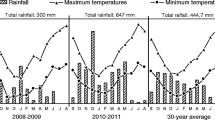Abstract
Florunner peanuts were grown in experimental plots with soil moisture and soil temperature modified during the last third of the growing period to produce drought, drought with cooled soil, irrigated and irrigated with heated soil treatments. Twice each week, beginning 97 days after planting, random samples were harvested and maturities of individual pods were determined without destroying pod integrity. The nature and quantity of the microflora associated with the pods and kernels were subsequently assessed. Drought and lower soil temperature resulted in maturity distributions containing higher proportions of immature pods. On peanuts with no visible damage to the pod or kernel, colonization byAspergillus flavus was more frequent in immature than mature kernels. Drought stress increased the incidence ofA. flavus and irrigation decreased it, except when soil temperatures were modified.A. flavus infestation was greatly increased at all maturity levels by pod damage.
Similar content being viewed by others
References
Dickens, J.W., J.B. Satterwhite and R.E. Sneed, J.Am. Peanut Res. Ed. Assoc. 5:48 (1973).
Pettit, R.E., R.A. Taber, H.W. Schroeder and A.L. Harrison, Appl. Microbiol. 22:692 (1971).
McDonald, D., and C. Harkness, Trop. Sci. 9:148 (1967).
Sellschop, J.P.F., Symp. Mycotoxins in Foodstuff, Agric. Aspects, Pretoria, South Africa, 1954, p. 47.
Diener , U.L. , and N.D. Davis , AL, Agric. Exp. Sta. Bull. 493 (1977).
Austwick, P.K.C., and G. Ayerst, Chem. Ind. (London) 2:55 (1965).
McDonald, D., and C. Harkness, Trop. Sci. 6:12 (1964).
McDonald, D., and C. Harkness, Ibid. 7:122 (1965).
Diener, U.L. C.R. Jackson, W.E. Cooper, R.J. Stipes and N.D. Davis, Plant Dis. Rep. 49:931 (1965).
Blankenship, P.D., R.J. Cole and T.H. Sanders, Proc. Am. Peanut Res. Ed. Assoc. 12:46 (1980).
Drexler, S.J., and E.J. Williams, Ibid. 11:57 (1979).
Griffin, G.J., and K.H. Garren, Phytopathology 64:322 (1974).
Dreyer, J., “Growth Response of Peanuts (Aracbis bypogaea L.) with Different Fruiting Zone Temperatures,” Ph.D. disser- tation, University of Florida, 1980.
Wells, T.R., and W.A. Kreutzer, Phytopathology 62:797 (1972).
Griffin, G.J., and K.H. Garren, Ibid. 66:1161 (1976).
Author information
Authors and Affiliations
About this article
Cite this article
Sanders, T.H., Hill, R.A., Cole, R.J. et al. Effect of drought on occurrence ofaspergillus flavus in maturing peanuts. J Am Oil Chem Soc 58, A966–A970 (1981). https://doi.org/10.1007/BF02679302
Issue Date:
DOI: https://doi.org/10.1007/BF02679302



